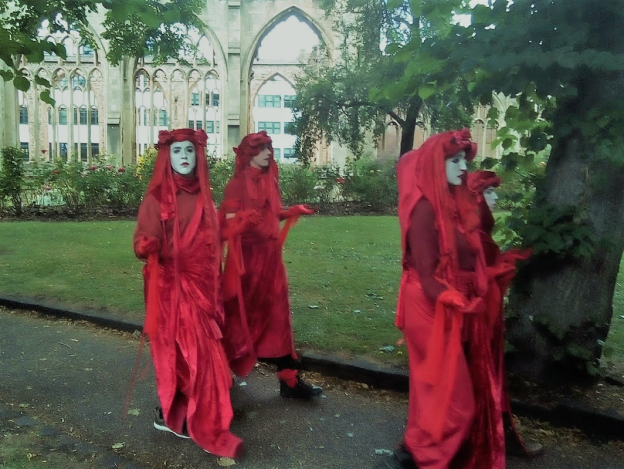By Maria Nita
I would like to explore here some of the cultural roots and influences on the Extinction Rebellion movement, since this will shed light on the discourses that can be revived when XR is discussed in the public domain, be it by politicians, the general public or the media. For example, when climate activists are described as ‘uncooperative crusties’ in their ‘heaving hemp-smelling bivouacs’ (Rawlinson, 2019), we can recognise a well-established anti-hippie discourse which dominated public concerns over the free festivals in the UK, in the early 1970s. Such remarks are not dissimilar to those I found in my archival data from the free festivals, when the hippies were often vilified as ‘smelly’, ‘long hair types’, ‘a lunatic fringe’, ‘drug pushers’, ‘addicts’ and so on (Nita and Gemie, 2019). Surprisingly, it was the Christian clergy that had an important conciliatory tone and a role in recognizing the Christian values in the hippie movement – which in time helped legitimize the early festivals and indeed the ensuing, gone mainstream, festival culture.
Early festivals, protestivals, non-violent disobedience
We can trace some of XR’s ideological and cultural roots in the early festival movement, as well as the earlier 1960s communes, which had a similar mix of civil disobedience, artivism – or artistic activism, cooperative ethos, communalism, and of course anticipating a world in deep crisis future which the commune could withstand (Miller, 1990). Certainly, as an heir of the early festivals – the ‘protestival’ – has been a common form of expression for the alter-globalization movements we have seen since the 1980s (St John, 2008), as well as many contemporary movements of artistic social reform, such as the global Occupy Movement in recent history (Tremlett, 2016). However, XR is also extending its countercultural roots, reaching out towards the mainstream, in new ways. The unprecedented urgency of the ecological crisis means that XR needs to reach many more people than the original Climate Movement was able to, and its inspiring policy of ‘radical inclusivity’ – welcoming ‘everyone and every part of everyone’ – can be seen an open invitation to those who might not see themselves as green activist material. By tracing its own non-violent disobedience origins to the civil rights movement, and often linking the movement to Martin Luther King and Gandhi, XR aims to widen its scope from an earlier Climate Movement that recognised its limitations as a largely white and middle class movement, to one that is entirely relevant to multicultural communities and current widespread concerns with inclusion: see for instance XR’s swift response to condemn co-founder Roger Hallam’s offensive remarks towards the Holocaust (November, 2019).
A changed Climate Movement
Having researched the Climate Movement as an ethnographer/ anthropologist concerned with Christian and Muslim activists since 2008, I was naturally excited by its revival and re-invention as the Extinction Rebellion movement. A key driver for the renewal and growth of the Climate Movement was the publication of the last International Panel for Climate Change (IPCC) report – which states that carbon dioxide (CO2) would need to fall dramatically by 2030 – to limit warming to 1.5 degrees. Past this threshold – the changes will be catastrophic, with loss of many ecosystems. Back in the field, I could see that the fabric of this revived movement was tangibly and visually changed. If the ‘early’ Climate Movement had used colours of green, blue and white in many of its marches and global days of action, to represent the raising waters or the vanishing ice caps for example – XR flew back in and blocked big capital arteries and village capillaries with dramatic colours of extinction and grief, blood and funerals – deep reds and black being at the forefront of its performative actions, like the iconic Red Brigade pictured here.
Can XR change our extinction trajectory?
My research suggests that, notwithstanding the global growth and influence of contemporary non-violent resistance movements (Chenoweth and Stephan, 2011) – from Brazil’s indigenous tribes to the Arab Spring – we find in XR a model of protest and social change that is pivotally rooted in the cultural landscape of a post Christian society: a type of protest that is non-violent, sacrificial, communitarian and performative. More so, the small components of this model – the semiotics or internal grammar of performative actions – reveal a deeply familiar underlay. From XR songs to performative actions, such as ‘die ins’ – when protestors lie on the ground as if dead – to making their bodies go limp as they are being arrested and carried away by the police – we recognise in many XR public rituals a heroic vulnerability that has Christian resonance. Given my claim that Christianity represents an original and persistent model for cultural change (Nita, 2018), I have hope that XR can make as many of us as possible – and most importantly our political leaders – committed to a sustainable future, since this is the only one possible.
References:
Chenoweth, Erica and Maria J. Stephan. 2011. Why Civil Resistance Works: The Strategic Logic of Nonviolent Conflict. New York: Columbia University Press.
Miller, Timothy. 1990. The 60s Communes: Hippies and Beyond. Syracuse University Press.
Nita, Maria. 2018. ‘Christian Discourses and Cultural Change: The Greenbelt Art and Performance Festival as an Alternative Community for Green and Liberal Christians’, Implicit Religion, 21 (1): 44-69.
Nita, Maria and Sharif Gemie. 2019. ‘Counterculture, Local Authorities and British Christianity at the Windsor and Watchfield Free Festivals (1972–75)’ in Twentieth Century British History [online] https://doi.org/10.1093/tcbh/hwy053
Rawlinson, Kevin. 2019. ‘Extinction Rebellion’, The Guardian, 8 Oct 2019 [online] http://bit.ly/GuardianExtinctionRebelion [accessed 24 November 2019].
St John, Graham. 2008. ‘Protestival: Global Days of Action and Carnivalized Politics in the Present’, Social Movement Studies, 7 (2): 167-190.
Tremlett, Paul-François. 2016 ‘Affective Dissent in the Heart of the Capitalist Utopia: Occupy Hong Kong and the Sacred’, Sociology, 50 (6): 1156-1169.

